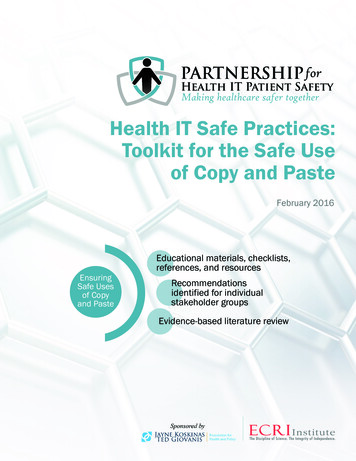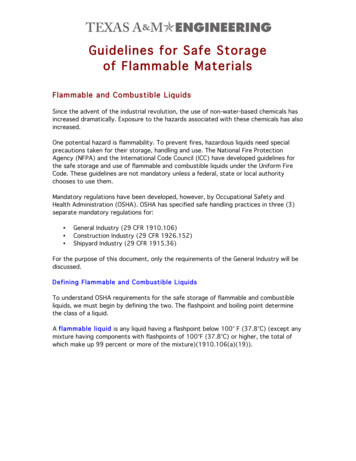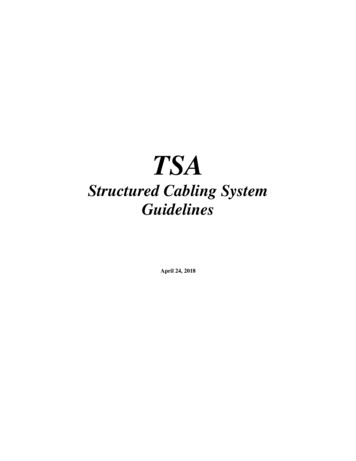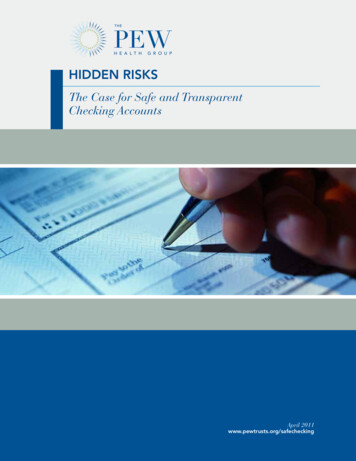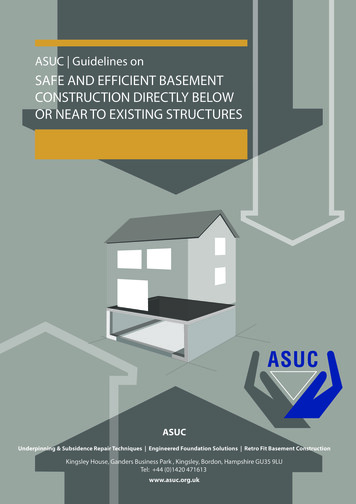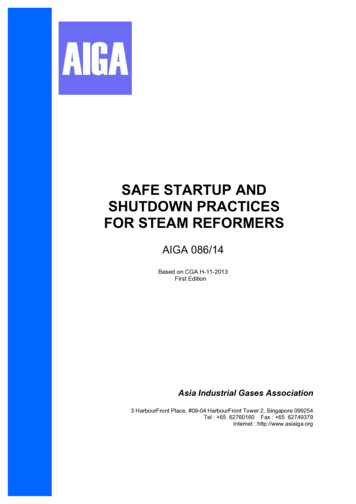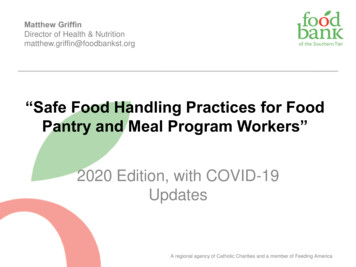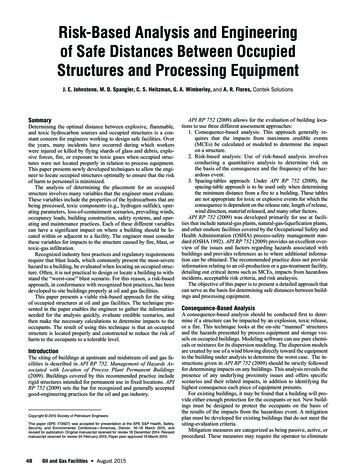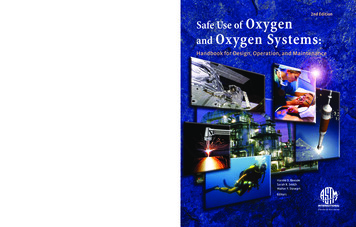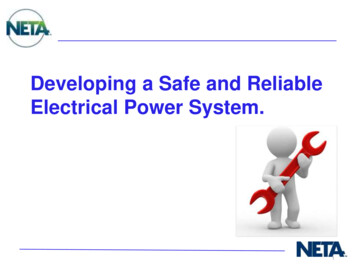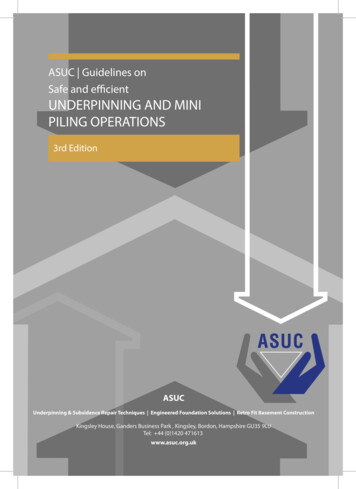
Transcription
ASUC Guidelines onSafe and efficientUNDERPINNING AND MINIPILING OPERATIONS3rd EditionASUCUnderpinning & Subsidence Repair Techniques Engineered Foundation Solutions Retro Fit Basement ConstructionKingsley House, Ganders Business Park , Kingsley, Bordon, Hampshire GU35 9LUTel: 44 (0)1420 471613www.asuc.org.uk
ASUCASUC is an independent trade association formed by a number of leading contractors to promote professionaland technical competence within the underpinning industry. Members offer a comprehensive range ofspecialist domestic services in: underpinning and subsidence repair techniques, engineered foundation solutionsand retrofit basement construction. Any contractor wishing to join ASUC must first undergo a technical, health &safety, insurance and financial audit and make a commitment to prescribed safety procedures.It publishes a number of useful documents on underpinning and related activities and a comprehensivedirectory of members all of which are freely available to download via the website. ASUC members offer 10 or12 year, depending on the nature of the works, insurance backed latent defects guarantees.Main authorsRob Withers - ASUC Executive DirectorDavid Kitching – Stress UK LtdLewis O’Connor – Abbey Pynford GroupIndustry comments fromHurst Pierce and MalcolmAbbey Pynford GroupMorcon FoundationsPhotographs and DiagramsAbbey Pynford GroupFalcon Structural Repairs LtdForce Foundations Ltd t/a Basement ForceKixx Ltd – Mike DarbyLarsen Foundations LtdNeil Foundations LtdPatterson Construction LtdMJ Rooney ConstructionU&M GroupAlthough care has been taken to ensure, to the best of our knowledge, that all data and information containedin this document is accurate to the extent that it relates to either matters of fact or accepted practice or matters ofopinion at the time of publication, neither ASUCplus, the authors or contributors nor the co-publishers will beliable for any technical, editorial, typographical or other errors or omissions in or misinterpretations of the dataand information provided in this document. Since this document may be subject to change and updating, thedata and information which it contains is only correct at the time of publication. Compliance with thisdocument does not of itself infer immunity.Part-funded byThis project has been delivered with support from the CITB Growth Fund, which aims to ensure that theconstruction industry has the right people, with the right skills, in the right place, at the right time and isequipped to meet the future skills demands of the industryGuidelines on safe and efficient Underpinning and Mini Piling works directly below or near to existingstructures ISBN: 978-0-9545370-0-5 ASUC: revised March 2015, October 2014 First issued ASUC 2003.
ASUC GUIDELINESOn safe and efficient Underpinning and Mini Piling works directly below or near to existing structuresCONTENTS1.EXECUTIVE SUMMARY. 32.INTRODUCTION . 53.DEFINITIONS . 74.TYPES OF UNDERPINNING AND MINI PILING . 85.TECHNIQUES USED IN UNDERPINNING AND MINI PILING WORKS . 166.MINI PILING . 197.GROUND IMPROVEMENT . 248.TEMPORARY WORKS . 279.IMPACT ON OTHERS . 3310.FACTORS AFFECTING CHOICE OF CONSTRUCTION TECHNIQUE AND METHOD . 3711.HEALTH AND SAFETY . 3912.THE PROJECT TEAM . 4913.PROCUREMENT . 5214.INSURANCE . 5515.GUARANTEES . 5916.DOMESTIC PROPERTY OWNER CONSIDERATIONS . 6117.LIST OF APPENDICES . 6418.APPENDIX A - SITE INVESTIGATIONS . 6519.APPENDIX B - BUILDING DAMAGE CLASSIFICATION . 6920.APPENDIX C - SAFETY HAZARDS AND MITIGATING ACTIONS . 6921.APPENDIX D - HEALTH HAZARDS AND MITIGATING ACTIONS . 7722.APPENDIX E: PLANNING FOR RISK MANAGEMENT –DETAIL ON INFORMATIONREQUIRED. 8223.APPENDIX F: ASUC UNDERPINNING AND MINI PILING WORKS INDEMNITY GUARANTEE(DIG) POLICY . 8324.APPENDIX G: Construction (Design and Management) Regulations 2015 – CDM 2015. . 9025.GLOSSARY OF TERMS. 9326.REFERENCES . 941
SPECIAL NOTE RELATING TO CDM REGULATIONS AND PUBLICATIONrdThe principle reason for issuing a 3 Edition is to enable the section in Appendix G to be added in relation to CDMth2015 and the changes to the law with effect from 6 April 2015. In addition it has enabled changes due to some ofthe industry comments, for which ASUC is very grateful.Published by ASUCKingsley House, Ganders Business Park, Kingsley, Bordon, Hampshire GU35 9LU www.asuc.org.uk2
1.EXECUTIVE SUMMARY1.1The Association of Specialist Underpinning Contractors (ASUC) is publishing these guidelines to improvethe safety and efficiency of underpinning and mini piling construction to reduce negative impact onothers, especially people living or working near to underpinning projects.1.2The objective of these guidelines is to enable clients, designers, engineers and others involved inUnderpinning and Mini Piling works projects to instruct safe and efficient work.1.3Underpinning and Mini Piling works are a complex form of building involving geotechnical, hydrological,structural and civil engineering and health and safety expertise that even those with significantconstruction experience may not have encountered previously.1.4The single leading principle throughout these guidelines is the absolute priority that health and safetyhas over all other aspects of a project.1.5Temporary works (support to existing buildings and to the ground around excavations) is critical and isoften overlooked or addressed superficially.1.6The main construction techniques used for Underpinning and Mini Piling works structures are massconcrete , pile and beam and/or piled rafts1.6.11.6.2There are two main types of underpinning: mass concrete underpinning and reinforcedconcrete (RC) underpinning (underpinning piers with reinforced concrete beams). Mass concrete underpins provide vertical support underneath existing RC underpins can usually provide vertical support underneath existing walls and retainthe ground outside the Underpinning and Mini Piling works Piers and beams provide a more cost effective solution in some circumstances wherebypiers are cast at approx. 3m centres and tied together with an RC beam which is insertedinto the existing structure using specialist temporary supports known as “stools”In Underpinning and Mini Piling works two main types of piles are used; reinforced concrete(RC) bored piles and driven piles. Mini piles are constructed in sections with augers typically 1 m in length; this enablespiles up to say 15m deep to be constructed in restricted headroom situations. Driven piles will typically be 100-150mm diameter steel tubes driven either from the topwith a percussion drill (like a kango hammer) or more likely bottom driven using agrundomat. A technique used for the spoil less drainage technology in placing gas pipesetc. underground without the need for a lot of excavation. The vibration of thistechnique is low, but equally loads that these piles can achieve are low as well- 50Knwould be a conservative figure.1.7Building below the groundwater level adds complication and cost to any Underpinning and MiniPiling works project. There are several methods for building below the groundwater level. Carefulconsideration of the most appropriate method will be needed for each project where groundwater isencountered.1.8Temporary works in Underpinning and Mini Piling works a r e used to support excavations, existingstructures, equipment and plant, and site facilities. Support for excavations and existing structuresare critical. Temporary works for excavations covers support for individual underpin excavations andfor the whole site during the main bulk excavation after the Underpinning and Mini Piling works wallshave been built.1.9Temporary works should be designed by a suitably qualified and experienced engineer called theTemporary Works Engineer (TWE). In addition to the TWE a Temporary Works Coordinator (TWC)must be appointed who has overall responsibility for the temporary works on site.1.10Underpinning and Mini Piling works can have a significant negative impact on people not involvedwith the work, especially local residents. The main negative impacts come from: Potential to damage surrounding buildings and structures Noise, vibration and dust Traffic3
1.11There will always be some negative impact but this should be minimized through early engagement,imaginative planning and considerate execution.1.12In addition to health and safety, which is the single most important priority, the other main factors toconsider when choosing the construction technique and sequence are Occupier's desire to live in the existing building during the works Structure and condition of the existing building Party wall matters Soils and geology Hydrogeology especially groundwater which, if present, has a significant impact Surrounding structures Site access Impact on others1.13Underpinning and Mini Piling works under or near existing structures has a high level ofconstruction hazard. Collapse of excavations, collapse of existing buildings and falls from height,including into excavations, are the three safety hazards most likely to lead to death or seriousinjury. Exposure to asbestos and to dust containing silica are the two health hazards most likely tocause death or serious injury.1.14Domestic and Business clients, designers and contractors all have extensive duties under theConstruction (Design and Management) Regulations 2015. Designers and contractors must managerisk by: Completing risk assessments Avoiding risk where possible preferably by design Reducing risk throughout Developing safe methods and systems of work Managing and monitoring risk throughout Using only suitably trained and experienced personnel Having effective emergency plans and proceduresAppendix G shows the guidance in relation to CDM 2015 for all parties concerned.1.15Only responsible, competent and experienced designers and contractors should be appointed.1.16Comprehensive first party indemnity latent defects insurance provides the best form of guaranteecover. The cover for the ASUC Underpinning and Mini Piling works Insurance Guarantee (DIG) is thistype of guarantee.1.17The composition of the project team will vary by project. Apart from the Client the project team caninclude a Structural or Design Engineer, Temporary Works Engineer, Temporary Works Coordinator,Principal Contractor, Party Wall Surveyor, Quantity Surveyor, Principle Designer and others. AStructural or Design Engineer will always be needed in the design team. The Structural or DesignEngineer can be an independent consultant or can be retained by a design and build contractor.1.18Underpinning and Mini Piling works work can be procured by any of the four main procurementmethods: traditional design then tender, design and build, management or integrated. There is nosingle best method and they each have advantages and disadvantages. It is important to choose a formof procurement that incentivizes safe and efficient construction.1.19The right insurances should be in place to protect all parties. The main insurances are: ProfessionalIndemnity (PI), Employer’s Liability (EL), Public Liability (PL), Contractors All Risks (CAR), nonnegligent for third party property (JCT 21.2.1 / 6.2.4 / 6.5.1 insurance), existing buildings, andnon-negligent damage to the client's property. Insurance cover for Underpinning and M
1.6.1 There are two main types of underpinning: mass concrete underpinning and reinforced concrete (RC) underpinning (underpinning piers with reinforced concrete beams). Mass concrete underpins provide vertical support underneath existing RC underpins can usually provide vertical support underneath existing walls and retain the ground outside the Underpinning and Mini Piling works
